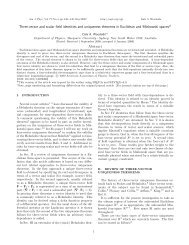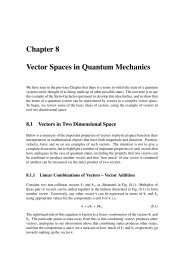Electrostatic Fields in Matter
Electrostatic Fields in Matter
Electrostatic Fields in Matter
You also want an ePaper? Increase the reach of your titles
YUMPU automatically turns print PDFs into web optimized ePapers that Google loves.
The amount of charge <strong>in</strong> the element <strong>in</strong> the diagram is the productof the element’s volume and the charge per unit volume:i.e. the charge is: (da×t)×(nQ) = nQd cos θda = n⃗p· ⃗da = ⃗ P · ⃗da(8)The surface charge density (i.e. the charge per unit area) is thus:σ b = ⃗ P · ˆn (9)where ˆn is a unit vector, perpendicular to the surface and po<strong>in</strong>t<strong>in</strong>gout of the surface.6.2 Volume Bound Charge DensityWe saw above, that the net charge flow<strong>in</strong>g across a surface when adielectric is polarised is P ⃗ · ⃗da. If the volume is enclosed by a surface,then the net charge which flows out of that volume is given by :∮Q out = ⃗P · ⃗da (10)areaThe charge left beh<strong>in</strong>d <strong>in</strong> the volume is just −Q out .∮∮−Q out = − ⃗P · ⃗da = − ∇ · ⃗P dτ (11)areaThe last step uses Gauss’ theorem.What this tells us is that the net charge density <strong>in</strong>side the volumeelement is :volρ b = −∇ · ⃗P (12)Note that s<strong>in</strong>ce the volume charge density depends on spatialderivatives of the polarisation, it will be zero <strong>in</strong>side a uniformly polariseddielectric.7
















